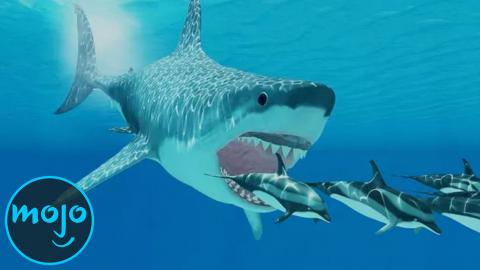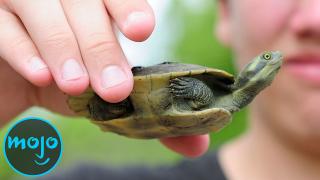Top 10 Facts About the Megalodon

No, this is not a creature from a nightmare, but it certainly sounds like one. From their history, to their appearance, to the sheer enormity of this enigma, chomp on these facts! WatchMojo counts down the Top 10 Facts About the Megalodon.
Special thanks to our user boxtroll for suggesting this idea! Check out the voting page at WatchMojo.comsuggest/Top+10+Facts+about+the+Megalodon.
Script written by Nathan Sharp
#10: The Megalodon Went Extinct 2.6 Million Years Ago
What If Megalodon Sharks Didn't Go Extinct?
The megalodon enjoyed a prosperous lifespan of roughly twenty million years. There are conflicting reports regarding the evolution of the megalodon, with some arguing that it evolved 28 million years ago while others place it in the 16-23 million years ago range. Regardless, experts generally agree that it went extinct near the end of the Pliocene epoch roughly 2.6 million years ago. While that may seem like a lot, that is a fraction of a second on the cosmic timescale. And the best part is, no one really knows why it went extinct. However, most agree that it resulted from a combination of climate change and a lack of food.
#9: Despite Appearances, the Great White Probably Didn’t Descend from the Megalodon
Top 20 Alexander the Great Facts
While researchers are still not 100% agreed on the relation between the megalodon and the great white, they’re pretty sure that they are not actually related, contrary to popular belief. Or they’re like distant cousins five times removed or something, which no one ever really counts. Researchers originally thought that the megalodon belonged to the genus Carcharodon along with the great white, but now they believe that they belonged to an extinct genus called Carcharocles. They’ve discovered that the great white is most likely descended from and are more closely related to mako sharks than megalodons, whose family died out around two million years ago.
#8: Its Teeth Are Relatively Common Fossils
Top 20 Facts About Infamous Gangs
The megalodon populated many areas of the world, and as such, its fossilized teeth are quite common. Now, when we say this, we don’t mean that it’s common to come across a massive seven-inch long tooth while walking the beach. Those are very rare and can fetch an exorbitant price online. For a large, intact tooth of six inches or more, you can expect the bidding to start around $800. However, smaller teeth are quite common. A tiny 2-3-inch tooth can range from $20-50, depending on quality and damage. So, while giant teeth are rare, it is certainly not unheard of to come across small and damaged megalodon teeth.
#7: Megalodon Nurseries Have Been Found
Even the massive megalodon had cute little nurseries. Well, giant, terrifying nurseries, but still. In 2015, researchers from the University of Florida discovered a 10-million-year-old megalodon nursery off the coast of Panama in an area known as the Gatun Formation. Others have been found in Maryland, the Canary Islands, and Florida. However, it was in the Gatun nursery that researchers found 400 small megalodon teeth, indicating a concentration of small and juvenile megalodons. And by juvenile megalodons, we mean 13-foot long sharks. Shark nurseries are typically found in shallow waters where larger prey cannot swim, and it turns out that the megalodon’s was no different.
#6: The Megalodon Would Bite Off Its Prey’s Fins
Top 100 Facts That Might Save Your Life One Day
The megalodon couldn’t just bite its prey and make quick work of it. Nope, it had to torture the pour souls and ensure that they felt every last painful bite. As if megalodons weren’t horrifying enough. Throughout the years, scientists have discovered fossilized whale flipper bones with ingrained megalodon teeth marks. They took this evidence and theorized that a megalodon would bite and rip off a whale’s fin to immobilize it in the water, wherein it would attack and feast without the fear of its prey making a quick escape. Not cool, megalodon. Not cool.
#5: Its Teeth Could Reach Up to 7 Inches in Length
Top 20 Facts About Saudi Arabia's The Line
A megalodon’s mouth sounds like a nightmare incarnate. As mentioned previously, megalodon teeth can vary wildly in size. However, the largest (and rarest) megalodon teeth are over seven inches in slant height, making these the largest teeth of any recorded species of shark. Megalodons also had over 250 serrated teeth in their mouths spread out over five rows. And to make matters worse, a large megalodon had a mouth span of over six and a half feet, meaning it could easily swallow even a tall human whole. And you thought great whites were scary…
#4: The Megalodon Was Found Throughout the World
Top 20 Creepiest Things Found Frozen in Ice
These terrifying creatures weren’t simply confined to one or two areas of the globe. Nope, they were practically everywhere. Megalodon fossils have been found throughout many areas of the world, including North America, Europe, Africa, and Australia. And while the megalodon greatly enjoyed warmer, subtropical climates, it was could tolerate water as cold as 75 degrees Fahrenheit. It seemed as if the megalodon wasn’t picky about the waters it swam in either, as they could be found in the deep waters of the ocean, swampy lagoons, and shallow coastal waters. In short, there was nowhere these bad boys didn’t go.
#3: The Megalodon Ate Whales
Top 20 Weirdest Facts About US Presidential Elections
Fossil evidence has been found suggesting that megalodons feasted on a wide variety of whales, including bowhead, baleen, and sperm whales. Many fossilized whale bones and fins have been found embedded with megalodon teeth marks, and some excavations have even found large amounts of megalodon teeth near eviscerated remains of whales. However, whales aren’t the only thing they feasted on. Their enormous size and fast speeds made them apex predators of the sea, and they feasted on basically anything they could clamp their teeth on and around. Animals like dolphins, seals, and sea turtles also found themselves on the receiving end of powerful megalodon bites.
#2: It Had the Most Powerful Bite of Any Known Animal
Top 10 Animal Facts to Make You Sound Smarter
Yeah, you could say that the megalodon was pretty darned strong. Before we get to the megalodon’s bite force, let’s take a look at some other animals. Our wussy bite force averages around 1,300 newtons. Let’s face it, we can’t even get through a strong piece of taffy. A large saltwater crocodile’s is about 16,400. A great white shark’s is around 18,200. And the megalodon’s? Try 182,000 newtons. Yes, a megalodon has a bite force roughly 10x stronger than that of a great white, and even stronger than its land-based rival, the T-Rex. To put that into perspective, a megalodon could tear through your car with a single bite.
#1: The Megalodon Is the Largest Fish That Has Ever Lived
Top 10 Facts People from Russia Want You to Know
The megalodon not only has the strongest bite force of any known fish, but it’s also considered the largest. Estimates of the megalodon’s true size vary of course, but most experts believe that they averaged around 34 feet in length. However, large megalodons could reach up to 60 feet in length, making it roughly 3x the size of the largest recorded great white and the largest known fish to have ever lived. And they were heavy, too. A mature female could weigh up to 65 short tons, dwarfing a male sperm whale’s average weight of 45 short tons. In short, the megalodon was large, powerful, and possibly the scariest thing to ever walk (or rather, swim) the Earth.










